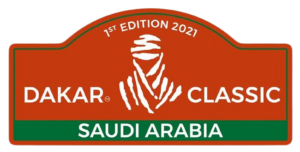ABC OF RALLY RAID
Bivouac
A camp at the end of every stage where all the teams and competitors set up their service. In addition to the medical centre and the media centre, the bivouac also features a big catering tent.
Briefing
During the rally, the organisation will hold a driver briefing on every evening. In this meeting, special incidents of the day will be brought up and hints for the coming stage will be provided.
CP
At this checkpoint, the competitors have to collect a stamp on their time card to be able to prove that they passed the checkpoint. Should a competitor have missed this checkpoint he will receive a time penalty.
Fast Assistance
As only competitors are allowed to help one another, in the Dakar, many teams join with a so called ‘Fast Assistance’. This Fast Assistance usually is a race truck that contests the event in the truck category and provides the competitors with extensive support in the case of an accident or a technical problem. The truck has got spare parts and tools on board.
GPS
In the Dakar, the GPS is used as control system. In the special stages, the competitors may navigate solely by dint of the road book. The GPS only confirms the arrival at and passing of the checkpoints.
Liaison (road section)
The liaison takes the competitors to the start and from the finish to the bivouac. It must be completed by the drivers in a specified time.
Neutralisation
A neutralisation phase can be embedded in a special stage. In this area, no time is added to the competitors’ tally.
Parc Fermé
Controlled and monitored area where the race vehicles have to be parked over an until and set time. During this time changes or even touching of the vehicles is strictly prohibited.
PC Course
The race control responsible for sports and safety-relevant aspects and for appeals.
Rest day
On this day, at rally half-time, no stage is contested and the competitors and vehicles stay in the bivouac. The teams use this day for extensive maintenance works on their cars.
Scrutineering
Here it is checked if the racing and service cars meet the technical regulations.
Roadbook
It contains all the important navigation information: Distances, dangerous passages and special instructions. The information is represented by arrows and symbols and numbers. In most rallies, the participants receive the roadbook when they enter the bivouac at the end of a stage. Since the Dakar 2020, the roadbook has been coloured and in several stages the participants even received the roadbook shortly before the start. Since 2021, the co-drivers at the Dakar and some other events have had the evening off, as the roadbook is only handed out a few minutes before the start of the stage. In some vehicles, a digital roadbook (on a tablet) was used.
Sentinel
An acoustic and optical warning system. Competitors are warned if a faster vehicle is approaching from behind what should make the overtaking easier.
Serviceroute
All service vehicles – i. e. all vehicles except the participants and the press vehicles – must travel from Bivouac to Bivouac on this route specified by the organisation.
Special Stage
The part of the stage the competitors have to contest as race against time. The time from the start to the finish of the special stage is used for the evaluation of the position in the overall standings. The overall result is the combined time of all special stages.
Stage
Stages consist of the liaisons, which bring the participants from the bivouac to the start or from the finish to the bivouac – and the special stage.
Speed zone
Here, the competitors have to abide by a certain speed limit that may amount to 30, 50 or 90kph. These zones were introduced to protect potential spectators and the terrain the competitors are driving through.
Time card
The start and finish times are recorded on this document. In addition, the co-drivers collect the necessary stamps at the checkpoints. (CPs).
Trip Master
An electronic measuring system (odometer) supposed to support the co-driver. It measures the total distance and individual stage distances (for instance between two points in the road book) and can be adjusted by the co-driver.
Way point (WP)
A point on the route that has been determined by the organisation and has to be passed by the competitors. There are four different types of way points: WPV, WPM (hidden way point), WPE (eclipse way point), WPS (safety way point).
